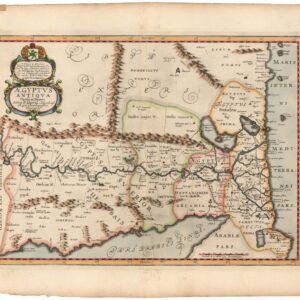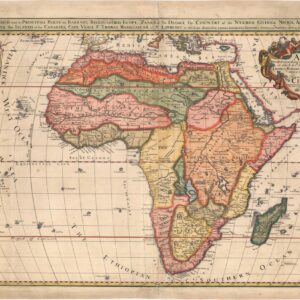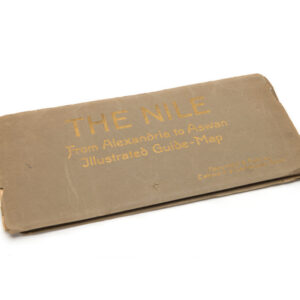Victorian-era case map of Angola that unfolds to depict Portugal’s largest and most important colony.
Provincia de Angola. Carta Dos Districtos De Benguelila e Mossamedes. 1895.
Out of stock
Description
This unusual cased folding map depicts parts of Greater Angola under Portuguese colonial rule. The map’s title, Provincia de Angola—Carta dos Districtos Benguella e Mossamedes, makes it clear that this is only part of the enormous African Country on the South Atlantic coast, suggesting this was part of a greater Portuguese mapping effort in the 1890s. The districts of Berenguella and Mossamedes cover the southern part of the country and make up the heartland of the Provincia Angola.
The map was commissioned by the Sedes dos concelhos, das capitanias móres e das colonies and drawn up by Portuguese mapmaker Luiz Filippe de Almeida Couceiro. It was presumably compiled following a number of topographical prospections throughout the 19th century and published in 1895. The publisher remains unidentified but was presumably operating either from Lisbon or the colonial capital at Luanda. The map was lithographed on paper, sliced, and then mounted on linen for easy folding into its case.
The map delineates the districts of Benguela and Mossamedes and was originally printed across four sheets. It maintains a scale of 1:1,000,000 and covers the geographical area between the 11th and 18th degrees of latitude South and the 11th and 25th degrees East of the Greenwich Meridian.
One exciting element of the map shows the routes taken by several 19th-century Portuguese travelers and explorers, who, in the minds of the colonial overlords, helped civilize this land by charting it topographically and scientifically. Among those listed is the Portuguese agronomist João Andrade Corvo (1824-1890), who later created the Comissão Central Permanente de Geografia, or Portugal’s Permanent Geographic Commission. The explorers’ itineraries also include the journeys of Cappelo and Ivens, Serpa Pinto, Arthur de Paiva, H. Paiva Couceiro, F. de Paula Cid, Silva Porto, Rodrigues Graça, Engineer Sampaio, Gonçalves, and Ladislau Maggar.
Context is Everything
Portugal’s colonial rule over Angola spanned several centuries, beginning in the late 15th century with the arrival of Portuguese explorers along the Atlantic coast of Africa. Initially motivated by a desire to discover new trade routes to Asia, the Portuguese soon established settlements and trading posts along Africa’s South Atlantic, many of which were located in what is now Angola. Over time, these outposts expanded into full-fledged colonies, marking the beginning of Portugal’s colonial presence in Southern Africa.
During the colonial period, Angola became a key source of enslaved people for the transatlantic slave trade, with millions of Africans forcibly taken from the region to work on plantations in the Americas, especially Brazil. This brutal trade inflicted immense suffering on the Angolan people and had lasting impacts on the country’s demographic, social, and economic structures.
In the 19th century, Portugal intensified its efforts to assert control over Angola, particularly in the face of competition from other European powers seeking to expand their colonial empires. This period saw the establishment of extensive colonial administrations aimed at exploiting Angola’s vast natural resources, including minerals, timber, and agricultural products.
Resistance to Portuguese colonial rule emerged among various Angolan ethnic groups, leading to armed conflicts and uprisings against colonial oppression. One notable rebellion was the Kimbundu and Umbundu revolt of 1902-1904, brutally suppressed by the Portuguese army. Despite these insurrections, Portugal maintained its grip on Angola throughout the 19th and much of the 20th centuries, ruling the territory as an integral part of its empire.
Portugal’s rule in Angola only ended in 1975, following years of armed struggle by nationalist movements seeking independence. The protracted conflict, marked by the Angolan War of Independence (1961-74) and subsequent civil war, left a legacy of devastation and instability that continues to shape Angola’s socio-economic trajectory to this day. Despite gaining independence, Angola faced significant challenges in the post-colonial era, including political unrest and profound economic disparity.
Census
The OCLC lists only a single example (1197913618) held by the Staatsbibliothek zu Berlin.
Cartographer(s):
Condition Description
Folding case map on original linen in original case with marbled interior covers. Scattered foxing. Wear along folds and in margins. Two spots of minor wormholes in right side panels.
References



